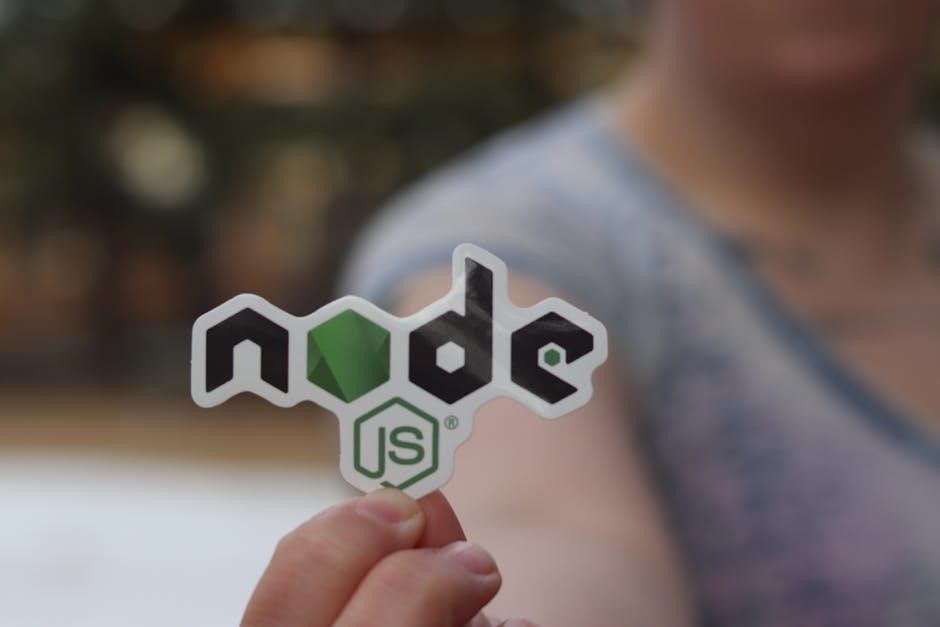JavaScript is a versatile scripting language powering web interactions, mobile apps, and server-side programming. Its ecosystem offers extensive resources, including tutorials and eBooks, making it accessible for beginners and experts alike.
What is JavaScript?

JavaScript is a lightweight, high-level, interpreted scripting language with a C-like syntax. It is primarily used for client-side scripting on the web, enabling dynamic interactions in web pages. JavaScript allows developers to create responsive user interfaces, validate forms, and manipulate content on web pages. Beyond web development, it is also used in server-side programming with Node.js, desktop applications, and mobile app development. JavaScript supports object-oriented programming, recursion, lambda functions, and closures. It is versatile, with applications extending to smart TVs and the Internet of Things. The language is continuously evolving, making it a cornerstone of modern web development and beyond.
Evolution of JavaScript
JavaScript, created by Brendan Eich in 1995, was initially named Mocha before being renamed to JavaScript. It was introduced as a scripting language for Netscape Navigator, aiming to add interactivity to web pages. The language gained popularity quickly, despite initial criticism, and became a standard in web development. In 1997, JavaScript was standardized by the European Computer Manufacturers Association (ECMA) as ECMAScript. Over the years, JavaScript has evolved significantly, with major updates in ES6 (2015) introducing features like arrow functions, classes, and async/await. The rise of Node.js in 2009 expanded JavaScript’s capabilities to server-side programming. Today, JavaScript is a cornerstone of modern web development, enabling both front-end and back-end functionality, and is widely used in emerging technologies like desktop and mobile app development.

JavaScript Fundamentals
JavaScript fundamentals include variables, data types, control structures, and functions, forming the base of the language. These elements enable developers to create dynamic web pages and interactive applications.
Variables and Data Types in JavaScript
In JavaScript, variables are declared using let, const, or var. The language supports various data types, including number, string, boolean, object, and undefined. Understanding these is crucial for effective scripting.
Control Structures in JavaScript
Control structures in JavaScript manage the flow of a program’s execution. Conditional statements like if/else and switch allow decision-making based on conditions. Loops, such as for, while, and do-while, enable repetitive task execution. Break and continue statements control loop termination and iteration. These structures are essential for creating dynamic, responsive applications, allowing scripts to adapt to varying conditions and user interactions.

Functions in JavaScript
Functions are reusable blocks of code that perform specific tasks. They enhance modularity and simplify code maintenance. JavaScript functions can accept parameters and return values, enabling dynamic interactions. They support closures, allowing inner functions to access outer scope variables. Additionally, functions like setTimeout and setInterval facilitate asynchronous operations, making JavaScript versatile for both synchronous and asynchronous programming. By organizing code into functions, developers create efficient, readable, and maintainable applications, leveraging JavaScript’s flexibility in web and server-side development.

Advanced JavaScript Programming
Explore advanced concepts like object-oriented programming, closures, and event handling. Learn how JavaScript extends beyond browsers, powering server-side applications with Node.js and enabling cross-platform development.
Object-Oriented Programming in JavaScript
JavaScript supports object-oriented programming through prototypes and classes. It allows for inheritance, encapsulation, and polymorphism, enabling developers to create reusable and modular code. Key features include constructors, methods, and properties, which facilitate the creation of complex objects. The prototype chain enables inheritance, where objects can inherit properties and methods from parent objects. Additionally, ES6 introduced classes, making OOP more intuitive and aligned with traditional OOP languages. This paradigm is essential for building scalable applications, from web apps to desktop programs. Understanding OOP in JavaScript enhances your ability to structure code efficiently and maintain large projects. It’s a cornerstone of modern JavaScript development.
Closures and the Module Pattern
Closures in JavaScript are functions that retain access to their lexical scope, enabling encapsulation of data and behavior. They are fundamental for creating private variables and methods. The module pattern leverages closures to define public and private members, promoting code organization and security. By returning an object with public methods, developers can control access to internal state. This pattern is invaluable for managing namespaces and preventing global scope pollution. Closures also empower asynchronous programming by preserving state across execution contexts. Together, closures and the module pattern enhance code maintainability and modularity, making them essential for robust JavaScript applications. Understanding these concepts is crucial for mastering advanced JavaScript programming techniques.
Event Handling and Manipulation
Event handling and manipulation are core concepts in JavaScript, enabling developers to create interactive web pages. Events, such as clicks, key presses, or page loads, trigger specific actions. JavaScript allows attaching event listeners to elements, enabling real-time responses to user interactions. The event object provides details about the occurrence, such as the target element or coordinates. Event propagation, including capturing and bubbling phases, can be controlled to manage how events are handled. Manipulation involves modifying event behavior, such as preventing default actions or stopping propagation. These techniques are essential for building responsive user interfaces, form validation, and dynamic content updates. Mastering event handling enhances the interactivity and usability of web applications, making it a critical skill for modern JavaScript development.

Applications of JavaScript

JavaScript is a versatile language used in web development, mobile apps, and server-side programming with Node.js. It enhances user interactions, enables dynamic content, and supports cross-platform applications.
Web Development with JavaScript Frameworks
JavaScript frameworks like React, Angular, and Vue.js revolutionized web development by enabling the creation of dynamic, interactive, and scalable web applications. These frameworks provide structured approaches to building user interfaces, managing state, and handling events. React, with its component-based architecture, simplifies building reusable UI elements, while Angular offers a comprehensive framework for complex applications. Vue.js, known for its progressive and flexible nature, combines the best of both worlds. Additionally, Node.js extends JavaScript’s capabilities to server-side development, allowing full-stack web development. These tools enhance efficiency, scalability, and maintainability, making JavaScript a cornerstone of modern web development.
Server-Side Programming with Node.js
Node.js revolutionizes server-side programming by enabling JavaScript execution outside the browser. Built on Chrome’s V8 engine, it offers an event-driven, non-blocking I/O model, ideal for real-time applications. Developers can create scalable and efficient servers, handling multiple connections simultaneously. Popular frameworks like Express.js and Koa.js simplify building RESTful APIs and microservices. Node.js also supports desktop and mobile app development, leveraging JavaScript’s versatility. Its ecosystem, powered by npm, provides millions of reusable packages, streamlining development. This flexibility makes Node.js a powerful tool for modern backend development, extending JavaScript’s capabilities beyond client-side scripting.
Desktop and Mobile App Development
JavaScript extends beyond web development into desktop and mobile app creation through frameworks like Electron and React Native. Electron enables building cross-platform desktop apps using web technologies, while React Native leverages JavaScript to craft native mobile applications. These tools allow developers to reuse code and skills, streamlining app development. Node.js further enhances this by providing backend capabilities, and npm offers extensive libraries for both desktop and mobile projects. JavaScript’s versatility ensures seamless integration with platforms, making it a preferred choice for modern app development. Its ecosystem supports rapid prototyping and scalable solutions, fostering innovation in both desktop and mobile spaces.

Learning Resources and Future Prospects
JavaScript learning is enriched by tutorials, eBooks, and frameworks. W3Schools, Stack Overflow’s eBook, and Node.js resources are popular. Future trends include cross-platform apps and IoT integration.

Best JavaScript PDF Tutorials and eBooks
Discover essential JavaScript learning materials through comprehensive PDF tutorials and eBooks. Learning JavaScript by Tim Wright and Pro JavaScript Techniques by John Resig are highly recommended. These resources offer detailed insights, practical examples, and advanced concepts. Additionally, community-driven guides like Eloquent JavaScript and JavaScript Enlightenment provide in-depth knowledge. For beginners, JavaScript for Kids and Coding with JavaScript for Dummies simplify complex topics. These eBooks are widely available, often for free, enabling developers to master JavaScript fundamentals and explore modern applications effectively.
Future Trends in JavaScript Development
JavaScript’s future is promising, with trends like enhanced ES6+ features, TypeScript adoption, and WebAssembly integration. Frameworks like React and Vue.js will continue to dominate, while AI-driven tools optimize development. Cross-platform apps built with Node.js, Electron, and React Native will grow. Security and performance improvements, such as Web Workers, will enhance functionality. JavaScript’s role in emerging technologies like AI, machine learning, and IoT will expand, making it a cornerstone of modern web and app development.



